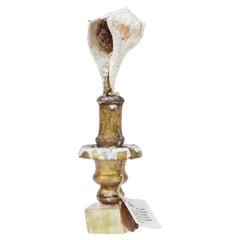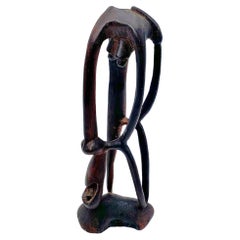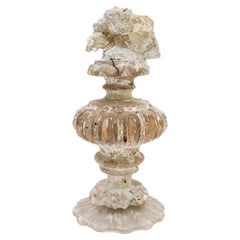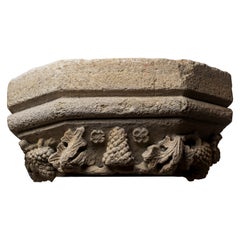Sculptures
18th Century Italian Rococo Antique Sculptures
Rock Crystal, Gold Leaf
1760s English Rococo Antique Sculptures
Porcelain
1950s Angolan Rococo Vintage Sculptures
Wood
Mid-18th Century French Gothic Antique Sculptures
Oak
18th Century Italian Rococo Antique Sculptures
Rock Crystal
15th Century and Earlier French Gothic Antique Sculptures
Stone
19th Century French Rococo Antique Sculptures
Carrara Marble, Siena Marble
Mid-18th Century French Rococo Antique Sculptures
Wood
19th Century French Rococo Antique Sculptures
Porcelain
15th Century and Earlier Italian Gothic Antique Sculptures
Stone
17th Century German Gothic Antique Sculptures
Oak, Paint
Late 19th Century German Rococo Antique Sculptures
Porcelain
Mid-19th Century German Rococo Antique Sculptures
Porcelain
15th Century and Earlier French Gothic Antique Sculptures
Walnut
18th Century Italian Rococo Antique Sculptures
Rock Crystal
Early 19th Century Italian Rococo Antique Sculptures
Statuary Marble
Late 20th Century Italian Rococo Sculptures
Porcelain, Silk
1850s German Rococo Antique Sculptures
Porcelain
17th Century French Rococo Antique Sculptures
Wood
17th Century Italian Rococo Antique Sculptures
Agate, Rock Crystal, Coral
20th Century Rococo Sculptures
Porcelain
1750s English Rococo Antique Sculptures
Porcelain
Mid-19th Century German Rococo Antique Sculptures
Porcelain
18th Century Italian Rococo Antique Sculptures
Agate, Coral, Gold Leaf
17th Century Italian Rococo Antique Sculptures
Quartz, Agate, Rock Crystal, Coral
Early 18th Century German Rococo Antique Sculptures
Porcelain
15th Century and Earlier French Gothic Antique Sculptures
Wood
15th Century and Earlier French Gothic Antique Sculptures
Limestone
Late 19th Century French Rococo Antique Sculptures
Porcelain
17th Century Italian Rococo Antique Sculptures
Rock Crystal
19th Century German Gothic Antique Sculptures
Other
17th Century Italian Rococo Antique Sculptures
Rock Crystal
15th Century and Earlier Spanish Gothic Antique Sculptures
Wood
15th Century and Earlier French Gothic Antique Sculptures
Oak
Early 2000s Hungarian Rococo Sculptures
Porcelain
17th Century Italian Rococo Antique Sculptures
Rock Crystal
18th Century Italian Rococo Antique Sculptures
Tourmaline, Quartz, Rock Crystal, Gold Leaf
Mid-18th Century English Rococo Antique Sculptures
Porcelain
Early 20th Century French Rococo Sculptures
Majolica, Porcelain
17th Century Italian Rococo Antique Sculptures
Coral
18th Century Italian Rococo Antique Sculptures
Agate, Coral
15th Century and Earlier Dutch Gothic Antique Sculptures
Wood
15th Century and Earlier French Gothic Antique Sculptures
Walnut
17th Century Italian Rococo Antique Sculptures
Tourmaline, Rock Crystal
15th Century and Earlier Spanish Gothic Antique Sculptures
Oak
17th Century Italian Rococo Antique Sculptures
Rock Crystal, Gold Leaf, Gold Plate
18th Century Italian Rococo Antique Sculptures
Rock Crystal, Copper
19th Century French Rococo Antique Sculptures
Bronze
15th Century and Earlier Unknown Gothic Antique Sculptures
Limestone
15th Century and Earlier Dutch Gothic Antique Sculptures
Oak
19th Century German Rococo Antique Sculptures
Porcelain
15th Century and Earlier Spanish Gothic Antique Sculptures
Wood
18th Century Italian Rococo Antique Sculptures
Rock Crystal, Tourmaline
15th Century and Earlier French Gothic Antique Sculptures
Wood
16th Century French Gothic Antique Sculptures
Oak
Early 19th Century English Gothic Antique Sculptures
Oak
1850s European Rococo Antique Sculptures
Bronze
18th Century Italian Rococo Antique Sculptures
Rock Crystal
Antique, New and Vintage Sculptures
Styling your home with vintage, new and antique sculptures means adding a touch that can meaningfully transform the space. By introducing a sculptural work as a decorative finish to any interior, you’re making a statement, whether you tend toward the dramatic or prefer to keep things casual with modest, understated art.
A single, one-of-a-kind three-dimensional figurative sculpture mounted on your dining room wall is a guaranteed conversation piece, while a trio of abstract works arranged on your living room bookshelves can add spontaneity to the collection of first-edition novels or artist monographs you’re displaying as well as draw attention to them. Figurative sculptures are representational works that portray a specific person, animal or object. And while decorating with busts, which are sculpted or cast figurative works, hasn’t exactly topped the list of design trends every year, busts are back. According to designer Timothy Corrigan, “They give humanity in a way that a more abstract sculpture can’t give.” Abstract sculptures, on the other hand, are not meant to show something specific. Instead, they invoke a mood or scene without directly stating what they are portraying.
Busts made of stone or metal may not seem like a good fit for your existing decor. Fortunately, there are many ways for a seemingly incongruous piece to fit in with the rest of your room’s theme. You can embrace a dramatic piece by making it the focal point of the room, or you can choose to incorporate several elements made out of the same material to create harmony in your space. If an antique or more dramatic piece doesn’t feel like you, why not opt for works comprising plastic, fiberglass or other more modern materials?
When incorporating sculpture into the design of your home — be it the playful work of auction hero and multimedia visionary KAWS, contemporary fiber art from Connecticut dealer browngrotta arts or still-life sculpture on a budget — consider proper lighting, which can bring out the distinctive aspects of your piece that deserve attention. And make sure you know how the size and form of the sculpture will affect your space in whole. If you choose a sculpture with dramatic design elements, such as sharp angles or bright colors, for example, try to better integrate this new addition by echoing those elements in the rest of your room’s design.
Get started on decorating with sculpture now — find figurative sculptures, animal sculptures and more on 1stDibs today.




